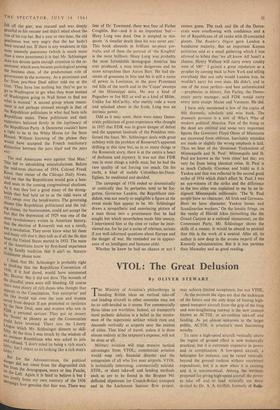VTOL: The Great Delusion
By OLIVER STEWART Fr HE Ministry of Aviation's philanthropy in handing British ideas on vertical take-off and landing aircraft to other countries may not be so soft-headed as it seems. For commercially those ideas are worthless. Indeed, air transport's most pathetic delusion is a belief in the immin- ence of the supersonic airliner which rises and descends vertically at airports near the centres of cities. That kind of travel, unless it is done almost entirely at the taxpayer's expense, will not be done at all.
Military aviation will reap massive tactical advantages from VTOL; commercial aviation would reap only financial disaster and the antagonism of all who live near airports. VTOL is technically interesting; commercially suicidal. STOL, or short take-off and landing methods such as are to be found in the Breguet 941 deflected slipstream (or Crouch-Bolas) transport and in the Lachmann laminar flow project, may achieve limited acceptance, but not VTOL.
At the moment the signs are that the technique of the future and the only hope of freeing high- speed transport aircraft from the grip of the long and ever-lengthening runway is the new concept known as ACTOL or air-cushion take-off and landing. As yet almost unknown to the larger public, ACTOL is aviation's most fascinating novelty.
To raise a high-speed aircraft vertically above the region of ground effect is now technically practical; but it is extremely expensive in power and in complication. A low-speed aircraft, a helicopter for instance, can be raised vertically beyond the ground cushion without exorbitant expenditure; but it is slow when it is cruising and it is uneconomical. Among the methods proposed for giving high-speed aircraft the power to take off and to land vertically are those devised by Dr. A. A. Griffith, formerly of Rolls-
THE SPECTATOR. JULY 14, 1961 Royce, and by various inventors and designers, American, French and British, including Sir Sydney Camm of Hawker. The Griffith method, Pioneered by the 'flying bedstead, uses separate batteries of lift engines to give direct jet lift and separate propulsion engines for forward flight— the Short SC-1 is an example. The Sydney Camm method uses the same power plant for vertical and for forward flight, the thrust line being made controllable by movable. vaned nozzles, as with the Hawker P-1127.
The feats of engineering which have made these two methods practicable are not to be underestimated. But however brilliant the engin- eering both methods must carry weight and Complication penalties. In forward flight the lift engines are non-paying passengers. And because there must always be. in vertical take-off aircraft, a system of control and stability which will work When there is no air flow over the ordinary con- trol surfaces and therefore no 'steerage way,' there must be a great deal of extra complication and a great deal of extra weight. For the airline operator the long runway is cheaper and simpler.
ACTOL, on the other hand, holds the promise Of achieving a form of vertical take-off for fast aircraft with relatively insignificant weight and complication penalties. It is intended to bring together the 'ground effect machine' and the high- Sneed aircraft and to make them one. The point of the ground effect machine—the Hovercraft is the best-known of the many types being built— is that it can lift itself off the ground and hover with a small expenditure of power for the weight carried. It is an economical form of vertical take-off craft, limited to the region of the ground cushion which, dependent upon the individual design, may be no more than 25 to 50 centimetres thick.
A cushion-rider can be lifted vertically and then driven over the ground at speeds which reach into the take-off speeds of ordinary jet aircraft. The ground over which it moves, though it must not be excessively rugged, need not be levelled °r given a hard surface. The power plant for emnpressing the air to form a cushion can be tile same as that used for forward flight. Stability ca
n be secured in the design of the constricting air Curtain.
At the Royal Aircraft Establishment, Farn- borough, it was seen some time ago that here were the possibilities of a remarkable, indeed a revolutionary, integration. Bring together into a single vehicle the cushion-rider and the super- sonic aircraft, and the runway's hold is loosened ithout prohibitive commercial penalties. The aPr°hlern resolves itself into devising a means of ,,ehieving a transition between cushion-riding 17°,d Ordinary aerofoil lift. Part of the aerofoil ,nut deveio-p,
as the forward speed on the cushion Isocreases; but the cushion must be broken and , mething substituted before free cruising flight Is attained.
This something is probably a modification of
t.ltre jet flap—also a Farnborough invention. In _P.eliminary wind-tunnel studies of a 'flying wing' :13_14:1form vehicle, a sheet of compressed gas is :aetro odueed at the moment the air cushion is to tra broken. In effect the vehicle is at that moment nsformed from a ground effect machine into a jet aircraft using full jet flap. It has taken off
vertically and economically and turned itself into something approaching a conventional sonic or supersonic aircraft.
Is this another brilliant aeronautical bramwave destined to be talked about and then forgotten? As yet it is too early to say. But it is already cer- tain that no other proposal for VTOL airliners holds any chances of commercial acceptance.



































 Previous page
Previous page